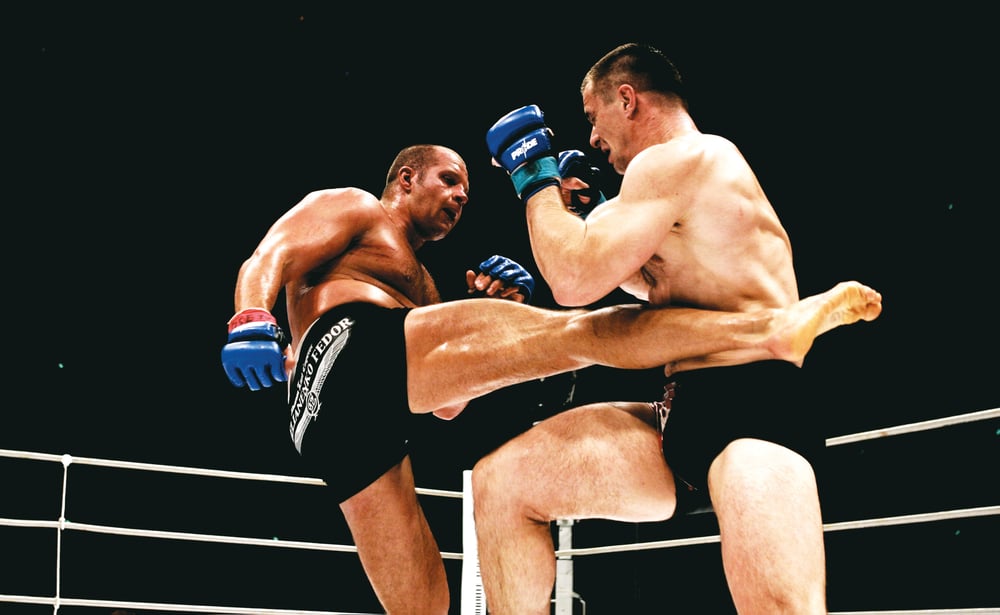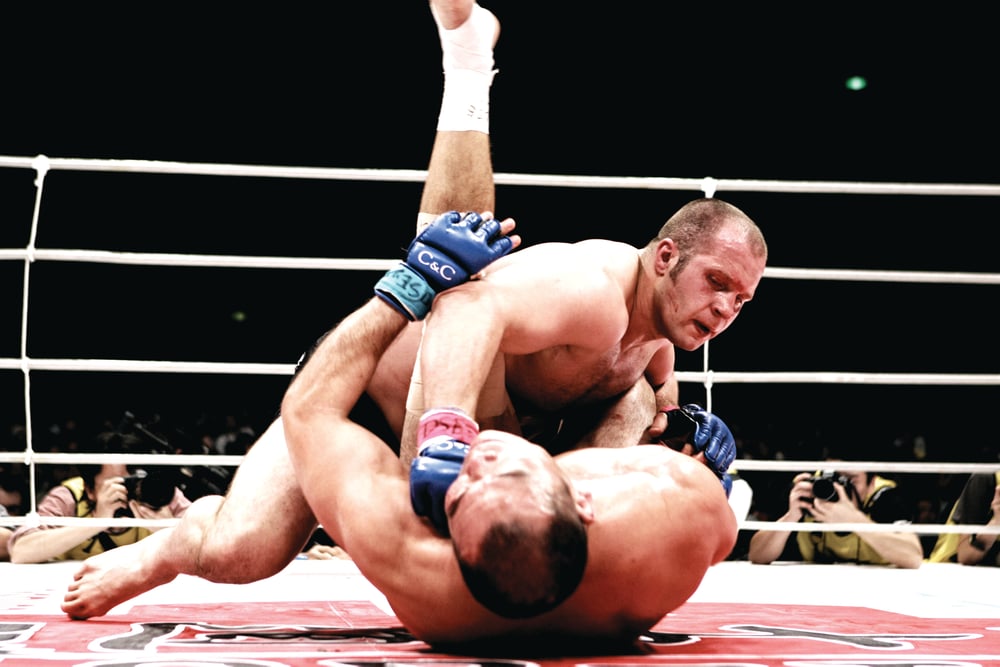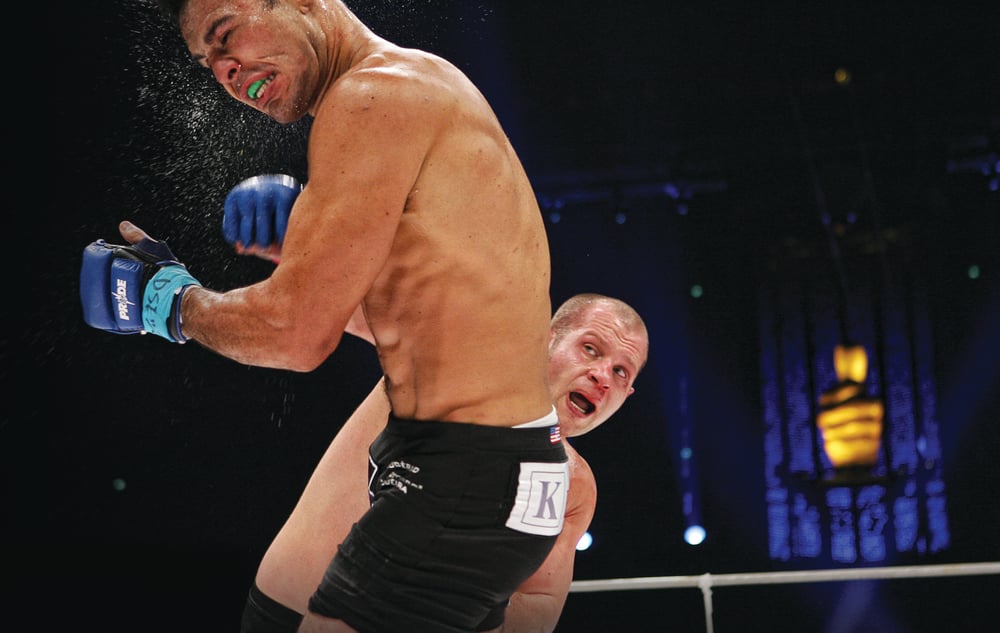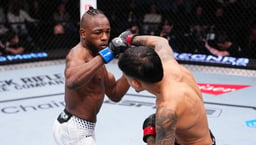
Issue 123
December 2014
Fedor Emelianenko enchanted many, but his accomplishments are at risk of being remembered by only a few in this era of UFC domination. Fighters Only and ‘The Last Emperor’ recall what made his undefeated Pride run so special.
Many stars were born and legendary fighting careers made inside the Pride ring, but one man’s success stands above them all. In the early 2000s, just as boxing was mourning the demise of Mike Tyson, MMA blossomed in Japan and a new ‘Baddest Man of the Planet’ entertained crowds using a savage aptitude for unarmed combat. The fact his ferocity came from behind a stoic demeanor made his feats even more captivating.
‘The Last Emperor’ Fedor Emelianenko was essentially the world’s undefeated heavyweight champion during Pride’s halcyon days. He wasn’t the biggest man in the famous white ring, nor was his set of individual skills far superior. But the whole was far greater than the sum of its parts. And when Fedor put it all together inside the ring, he was a wrecking machine. He was undefeated in Pride at a time when it had the best heavyweights on the planet. Of his 14 wins, 10 came inside the distance.
“When I fought in Pride we had the best fighters in the world. Back then the UFC had a very serious and big crisis, they were going through some tough times trying to get top fighters. All the best fighters were in Pride,” Emelianenko explains.
Despite his unbeaten record in the promotion, Fedor believes Pride officials never really wanted him as heavyweight champion and, at least initially, struggled to understand how to market him to fans.
Unlike Cain Velasquez, whose Mexican-American ancestry could unlock a whole new market for the UFC, the Russian heavyweight sensation wasn’t groomed for superstardom by Pride chiefs. In fact, many people thought he would be cannon fodder for then-number-two-ranked heavyweight Heath Herring in his second Pride fight in 2002.
This was despite Fedor’s 10-1 record in Rings – another Japanese promotion where he won a heavyweight title – and his dismantling of Dutch kickboxer Semmy Schilt in his Pride debut. Nevertheless, he faced Herring to decide the number-one contender for the heavyweight belt and forced a doctor’s stoppage after one round.
“Nobody expected me to become the champion,” Fedor says. “As far as what they wanted or didn’t want, I was not paying any attention to this. This is life. Even when I didn’t want something, I had to take it
into account.”
Instead, Fedor claims, Pride execs preferred Brazilian grappling superstar Antonio Rodrigo Nogueira as champion, or, later, Croatian kickboxing sensation and knockout king Mirko ‘Cro Cop’. After all, how do you sell a mere six-foot-tall, pudgy Russian to an audience in love with muscle-bound supermen?
However, Emelianenko would ultimately win his way into the hearts and minds of the Japanese audience and develop a cult following around the world with his destructive, conclusive, and calmly executed performances.
“I’ll say that later on Pride wanted him (Nogueira) to win the title and also Mirko to become champion,” says Emelianenko. “I could feel it and see it, but you can’t pay attention to this because it can shatter your psyche. You shouldn’t pay attention to this. You should come out, do your thing and win.”

Just four months after he TKO’d Herring at Pride 23 in November 2002, Fedor defeated Nogueira for the first time to claim the heavyweight championship he would never lose.
The Russian was only taken the full distance twice in his remaining Pride fights – once in a third fight with ‘Big Nog’ and once against Cro Cop. The rest, including eight first-round victims, would simply crumble under the pressure of his offensive game. That run of absolute domination also included his successful run to the 2004 Heavyweight Grand Prix championship.
Looking back at the unbeaten 15-fight streak with the organization that made him a global fighting icon, Fedor admits one or two performances stand out to him as his favorites. It should come as no surprise that they feature his two biggest rivals.
He says: “If I had to pick, it would probably be my first fight with Antonio Nogueira because it was for a title, and I won. Then, my fight with Mirko.”
Part of the long-term allure of Fedor was actually part of the problem during the early part of his reign. He was unable to communicate, even in English, to Japanese fans so his pre-fight publicity was limited. Pair that with his quiet and unassuming personality, and selling fights with him as the main event, initially at least, proved cumbersome.
Yet soon enough that same sedated persona became Fedor’s trademark and part of his intimidating championship reign. He explained the reason for his stern and cold demeanor: “I always remember that I represent not only myself, but also my country. People are making judgments about Russian people based on me. This is why I never allow myself any aggression toward my opponent.
“A fighter, a real strong fighter, should always look dignified and calm and I believe that any expression of aggression is an expression of weakness. A strong person will not be nervous and will not express aggression toward his opponent.
“He will be confident in his abilities and his training, then he will face the fight calm and balanced.”
Emelianenko’s combination of speed, power, and technical brilliance caused countless problems for opponents who were often much larger than him. His striking was more than a match for the world’s best kickboxers, while his sambo and judo base meant his grappling troubled even the most accomplished BJJ black belt. Fedor says it was his well-rounded ability that allowed him to dominate so ruthlessly.
“I was able to become successful due to my versatility – and through analysis and studying of my opponents,” says the now 38-year-old, who made friends in high places through his combat ability, including Russian president Vladimir Putin.
“You have to be multi-dimensional. You need to be a versatile fighter, unpredictable, and be able to fight equally well standing or (on the mat). You need to have it all, and you need to be able to adapt. The more versatile the fighter, the more interesting it is to watch.”
Though still considered by many hardcore fans as MMA’s true ‘Greatest Of All Time’ ahead of UFC standout Anderson Silva, the growth and success of mixed martial arts in the West during the past decade threatens to overshadow Emelianenko’s achievements in Pride.
Emelianenko couldn’t agree a deal to join the UFC when Pride closed in 2007 or when Affliction Entertainment folded in 2009, so he never set foot inside the Octagon.
“When Pride ceased to exist, the UFC didn’t immediately pick up speed,” Fedor acknowledges. “I spoke with the UFC and we had good talks and it was very reserved and very respectful. But the opportunity was never right.”
One of those ‘opportunities’ was rumored to be a heavyweight showdown with Brock Lesnar for a purse worth about $5 million for the Russian. Yet Fedor refuses to discuss the ones that got away: “I don’t think about it. I don’t think about fights that didn’t happen.”
In retrospect, he says, he made his mark. And the fact it didn’t happen on MMA’s present summit, but another peak entirely, doesn’t make it count any less. “Currently, the UFC is a super organization in the world, probably the best.
“There are several top fighters in every weight category. But back when I was fighting it was just Pride that was the best. And the best fighters in the world won and lost in Pride.”
In Mike Tyson’s words
“Fedor Emelianenko is my favorite of all time. He was always the smallest guy but he always came out victorious. I've never seen an athlete like him”

What made Fedor the greatest?
He may not have been the biggest or strongest, but ‘The Last Emperor’ was still the best in the world. How? Read on...
1. Grappling
A solid judo fighter and championship-winning sambo master – winning tournaments even during his MMA career – very few of The Last Emperor’s routes to the canvas involved the double-leg takedown that’s so ubiquitous in modern MMA. In keeping with his background, Emelianenko employed several high-percentage hip throws as well as inside and outside trips, which he combined with his well-known ferocity to ensure their success.
The Russian famously once said: “I don’t train jiu-jitsu at all. I train in sambo. Sambo is a superior fighting/grappling system.” That is, to a degree, reflected in the submissions he succeeded in getting: armbars, kimuras and chokes. All no-frills, bread-and-butter holds that epitomize his no-nonsense approach to fighting.
2. Ground & pound
If there was any one part of the Russian’s game that was as lauded as it was effective, it was his ground striking. More aggressive, forceful and cerebral than others who helped initiate or reinforce its popularity (Mark Coleman, Tito Ortiz or Matt Hughes), Fedor’s brand of mat striking was combined with his killer instinct and intelligence.
Often he’d bait his foe into a submission attempt then capitalize on their momentary lack of defense to land blows. Or else, he would simply attack while busying their arms with offensive maneuvers like guard passing.
Underlining it all was that Emelianenko didn’t look to score from this position, he looked to punish.
3. Intelligence
Fedor didn’t appear to do anything by chance when he was at the height of his capabilities. Of course if he saw opportunities he took them, but his most successful techniques worked because of either specific preparation or years of gym work. He didn’t simply throw any jab, he used the unorthodox ‘overhand’ jab he’d ascertained was most effective. He chose the best way to break a grip because it would mean he could best attack ‘Minotauro’ Nogeuira. Unlike some fighters who train positions, Fedor trained specifics and reaped the rewards.
4. Heart
Fedor’s tenacity was perhaps seen best in his 2004 Pride Grand Prix quarter-final fight against Kevin Randleman when ‘The Monster’ suplexed the Russian straight onto his head. The blow looked fight ending, even career threatening, yet only seconds later Fedor calmly swept his foe and secured a kimura to force the tap and secure an unlikely finish.

5. Boxing
With fast and heavy hands, Fedor was renowned for his concussive punches. In his prime, he would drive opponents up against the ropes and unload flurries of accurate strikes to the chin. Aware of their importance, he was also a legitimate body puncher, unlike a lot of mixed martial artists.
Pressure was a significant part of the sambo fighter’s game, too. He would often throw hands to rush inside on his opponent where he was free to land hooks as they covered up from the initial barrage.
The Russian’s lead right hand was also particularly well regarded. Aside from its role as a power punch that often found its mark when most expected a set-up left, he used it to quickly get into an upper-body tie-up and take his opponent to the floor.
6. Kicking
Perhaps an underused resource, Fedor learned his kicking game under regarded Dutch kickboxers such as Ernesto Hoost. Like much of his arsenal, his kicks were unorthodox, clinical, and destructive. When he fought Pride’s best kickboxer Mirko ‘Cro Cop’ he utilized his speed to kick the legs from under the Croatian as the former K-1 star threw his vaunted and feared head kicks.
It has been said the best facet of Emelianenko’s striking game was the variety of his techniques and how he used them in combination to open up other attacks. He understood that landing with a largely ineffective blow could open an opportunity for a far more destructive one.
...









